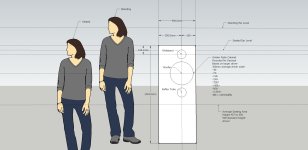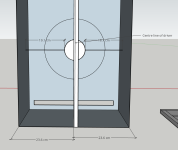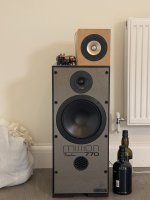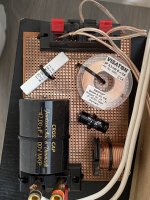300Hz is about the limit (altough Dave says higher)
I like lower, but it depends heavily on the woofer used. The largest i have used is 2x6.5” which have more extended frequency than your 10” ScanSpeak.
dave
Nice One, Waxx
The overall concept of a 3" to 5" wideband with 12" seems rather fascinating
I have only played with the concept in design and Sim
But otherwise very similar approach. 12" in a tower with wideband.
I always liked the tower concept regardless, since no stands needed.
The height is a good average between sitting and standing positions.
Far as the thread and the Pluvia HD7
the sensitivity is impressive for 80mm / 3 inch driver.
much higher than the average
I have tried it in simulation, it almost needs 2 woofers to match sensitivity
in full space. So in theory if done with 2 woofers, bass should be rather impressive.
Otherwise even though the HD7 has impressive sensitivity, it is almost easier
to use drivers on the low side to get everything to match easier in full space
on the flip side HD7 with slight highpass will really let it shine,
with less excursion
should have very clear mid/ highs as expected
The overall concept of a 3" to 5" wideband with 12" seems rather fascinating
I have only played with the concept in design and Sim
But otherwise very similar approach. 12" in a tower with wideband.
I always liked the tower concept regardless, since no stands needed.
The height is a good average between sitting and standing positions.
Far as the thread and the Pluvia HD7
the sensitivity is impressive for 80mm / 3 inch driver.
much higher than the average
I have tried it in simulation, it almost needs 2 woofers to match sensitivity
in full space. So in theory if done with 2 woofers, bass should be rather impressive.
Otherwise even though the HD7 has impressive sensitivity, it is almost easier
to use drivers on the low side to get everything to match easier in full space
on the flip side HD7 with slight highpass will really let it shine,
with less excursion
should have very clear mid/ highs as expected
Last edited:
Far as the thread and the Pluvia HD7
the sensitivity is impressive for 80mm / 3 inch driver.
A 4: driver with a 70mm ~ 3: actual cone size.
dave
Ahh...yes correct 70mm
Rather good sensitivity
As mentioned in Sim, Almost or could use 2x woofers
to get good matching lowend response in full space
I have worked on 2x 8" drivers
But really like the design idea of just 1x 12" driver
Rather good sensitivity
As mentioned in Sim, Almost or could use 2x woofers
to get good matching lowend response in full space
I have worked on 2x 8" drivers
But really like the design idea of just 1x 12" driver
In regards to the OP mentioning the Peerless SLS-P830669 as a candidate
I have had good results in sims for various other projects with the 12"
DS315-8
since it has somewhat high output /performance for a woofer
around 90 to 91 dB
Decent inductance for upper detail / crossover design
Healthy magnet for price range, closer to sub performance
than woofer
I have had good results in sims for various other projects with the 12"
DS315-8
since it has somewhat high output /performance for a woofer
around 90 to 91 dB
Decent inductance for upper detail / crossover design
Healthy magnet for price range, closer to sub performance
than woofer
good one, GM is quick!
Original found to try and do a Dynaco type easy fun project.
with no crossover used, just highpass for other driver
Otherwise try to keep 1st order friendly candidates in the library
But sensitivity cost/performance seems good too.
And as noticed old school, good bass in smaller places etc etc
In context to thread, remembered it for 91 dB ish sensitivity
towards the pluvia
Original found to try and do a Dynaco type easy fun project.
with no crossover used, just highpass for other driver
Otherwise try to keep 1st order friendly candidates in the library
But sensitivity cost/performance seems good too.
And as noticed old school, good bass in smaller places etc etc
In context to thread, remembered it for 91 dB ish sensitivity
towards the pluvia
I’m not a fan of square, or cube, boxes there is too much reflection and refraction. Maybe try a cylinder periscope or a wide box like Waxx built.Images attached here
If it needs to be 12" I would rather go for the SB34NRX75-6 or the Beyma 12BR70, i've used both in other configs, and both can be crossed fairly high while going low and being rather sensitive. Especially that Beyma is good,In regards to the OP mentioning the Peerless SLS-P830669 as a candidate
I have had good results in sims for various other projects with the 12"
DS315-8
since it has somewhat high output /performance for a woofer
around 90 to 91 dB
Decent inductance for upper detail / crossover design
Healthy magnet for price range, closer to sub performance
than woofer
True good pointI’m not a fan of square, or cube, boxes there is too much reflection and refraction. Maybe try a cylinder periscope or a wide box like Waxx built.
My concern with initial posted drawings was driver spaced so far apart.
Far as straight forward Rectangles. I tend to get good flat response
using wider Ratio.
Usually based on Golden Ratio. Using larger driver outer edge size in the design.
Likewise driver offset center for least diffraction based on smaller numbers from same
Golden Ratio
I have numerous generic drawings for reference for Golden Ratios
and drawn to see seating/standing heights
Anyways Here is basic Generic 498mm x 1304mm Golden Ratio Tower
for 12" driver. Ratio chart rounded up for no decimals.
I'll insert as thumbnail, likely click for larger view
Ironically in numerous sims I have found if driver
is offset according to Golden Ratio. Usually yields
move favorable diffraction. I make a measurement list from
small to large ratio based on largest driver.
Best location usually falls to the ratio

Thanks for clarifying – so it doesn't matter which part of the woofer's magnet is in contact with the brace, as the woofer might be off centre? I've attached a very crude diagram showing how this would work out in my example, with the woofer magnet off centre, and one face of the brace aligned to the centre line of the cabinet, but not the driver.The centre line of the cabinet.
I'll keep this in mind, thanks. I don't think 15mm will be much cheaper sadly. I'm surprised that thicker mdf doesn't have any acoustic benefits! I figured it would be stiffer and therefore deader?given the amount of effort, i would still buy ply. 15mm should be sufficient. The only benefit of using the thick MDF is thatthe material leaves more room for a larger chamfer.
Thanks Chris! Both look great. I'll do my best imitation...the brace would ideally extend to couple the front and rear panels as well as top and bottom, and can still allow for removable rear panel, as in the case of the attached photo of my A7 Pensil build
Okay, I think I'm getting lost now. I'm thinking I'll just order the parts for a super basic XO, test, and then go from there! If at any point I could steal a bit of your time to talk XOs over the phone, I'd be very grateful! I'll definitely be using a high pass to avoid over-working the full range, although I have no idea what a TT rumble filter is.To be 'safe' enough, yes.
Great stuff, thank you! I think I'll experiment with the pluvia 7 since I already own it, but will definitely think about switching to a bigger FR. I'd love to know how much power you get from this WAW. Does it live up to its physical size, or do you find you have to be careful not to over-work the Alpair at high volumes?did build similar waw, but used other drivers, mainly a bigger fullrange driver that goes lower on it's own in a sealed cabinet.
Good point! Maybe I should be looking for a more sensitive woofer, closer to the +6 dB ideal. I had looked at this Dayton, but it's annoyingly hard to get in Europe. I'll keep looking around, and maybe consider some other options. @waxx your suggestions look great – thank you 🙂DS315-8
Attachments
It's not in use now (i have many speakers), but i did power it with a 35W tube amp and it goes loud that way (in a 7x5x2m room). I'm planning to redo the crossover (from 1st order serial to 2nd order parrallel) and put it back in action soon. But the system can handle 80w i calculated. And it was used in a bigger space for a while also with a AR Ref75 amp (75w per channel) and it never felt stressed. I measured it and get 87dB at 1m/2.83v with the serial crossover. So at 35w that is about 102dB for a single, 105dB for a pair. That should be enough for most living rooms.
The thing that Mark Audio can't handle much volume is when using it fullrange at it's maximum power rating. The driver won't break, but it does sound a bit distorted (still relative low distortion). In a waw config this is not an issue as the biggest problem is bass on high volume from this 5.75" driver, and with a waw it does not do that. The pluvia in waw will be the same.
The thing that Mark Audio can't handle much volume is when using it fullrange at it's maximum power rating. The driver won't break, but it does sound a bit distorted (still relative low distortion). In a waw config this is not an issue as the biggest problem is bass on high volume from this 5.75" driver, and with a waw it does not do that. The pluvia in waw will be the same.
I figured it would be stiffer and therefore deader?
Definitely not stiffer, and not as well damped. Only asset is CHEAP.
dave
I just meant 25mm mdf vs 18mm mdf – I realise ply is stiffer and better damped than mdf in general!Definitely not stiffer, and not as well damped. Only asset is CHEAP.
At an average of 43lb/cu ft, working with 25mm MDF* has the added advantage of helping pay for your chiropractor/ physiotherapist’s wife’s Porsche Taycan.
*single 4x8 sheet scales in at around 115lbs, IIRC.
*single 4x8 sheet scales in at around 115lbs, IIRC.
Hi,If it needs to be 12" I would rather go for the SB34NRX75-6 or the Beyma 12BR70, i've used both in other configs, and both can be crossed fairly high while going low and being rather sensitive. Especially that Beyma is good,
Exactly, the 12BR70 is a nice and cheap driver. Used it as a twin in a middlesized OB. Not the last word in the deep bass, but dynamic and precise above 50Hz. No problem to meet a FR driver at a few hundred Hz. Recommended.
All the best
Mattes
Good plan! Only have a ~ 46 y.o. AT&T system and the Google Voice converter died with no direct replacement, so no phone ATM, though see that GV charges up to $2 US/minute to connect to UK!, so not practical since there's far more experienced folks much closer to you to help with complex computer designed XOs.Okay, I think I'm getting lost now. I'm thinking I'll just order the parts for a super basic XO, test, and then go from there! If at any point I could steal a bit of your time to talk XOs over the phone, I'd be very grateful! I'll definitely be using a high pass to avoid over-working the full range, although I have no idea what a TT rumble filter is.
Way back when, TurnTables/record players generated sub harmonics that would cause a woofer to flap around uncontrollably below a typically 35-40 Hz - up Fb tuning or even just below its Fs, so a TT 'rumble' filter was required.
Not only that, but it takes ~1.58" (~40.28mm) thick MDF to close enough match 18-19 mm BB, Apple, Marine grade ply, so better to add an exterior 0.75" MDF 'skin' to a 0.75"/whatever constructed cab that's narrower on at least three sides and add 1/4 round moulding to finish the corners or just same size of course or oversize (or not depending on the alignment) the cab to fit them internally.I just meant 25mm mdf vs 18mm mdf – I realise ply is stiffer and better damped than mdf in general!
That said, IME these glued on panels (please, no screws to weaken it!) need only be ~71% of the main panel's area and of course if properly braced, single sheet construction is fine too.
Last edited:
Here's a sim of your suggested design, done in Basta. The Peerless 830669 is in 74.5 litres sealed, and the Pluvia 7.2HD is in 4 litres. I've used 1st order electrical filter on the woofer (5mH), with a zobel (5.6 ohms, 36uF), which gives a reasonable approximation of a 2nd order acoustic filter. The Pluvia has 2nd order highpass (50uF and 4mH) and is padded down with a 1 ohm series resistor. Its phase is reversed.

The sim does not use any measurements or traced responses - just published T/S parameters, so it is of limited value. It does include baffle effects, though. (Traced responses, based on the drivers in different baffles, are of limited value too.) Real-world crossover might well benefit from different values.
I'd strongly urge you to get rid of the raised periscope, to get the drivers closer together. How about making the woofer box a little taller, and putting the Pluvia in a cylinder on top? Also, I'm not sure that venting that woofer box is a good idea. The Peerless woofer has quite high Qts, 0.54, and a vented box would need to be a lot bigger than 75 litres, I think, to work well. Even a sealed box could benefit from more litres. Crossover has ended up around 500Hz. Personally, I think that's fine for those drivers. I wouldn't worry about the Pluvia being too small. I have a 2 inch wide range driver crossed at 600 Hz to a 10 inch woofer, and I really like the combo.
Just my tuppenceworth. 🙂
The sim does not use any measurements or traced responses - just published T/S parameters, so it is of limited value. It does include baffle effects, though. (Traced responses, based on the drivers in different baffles, are of limited value too.) Real-world crossover might well benefit from different values.
I'd strongly urge you to get rid of the raised periscope, to get the drivers closer together. How about making the woofer box a little taller, and putting the Pluvia in a cylinder on top? Also, I'm not sure that venting that woofer box is a good idea. The Peerless woofer has quite high Qts, 0.54, and a vented box would need to be a lot bigger than 75 litres, I think, to work well. Even a sealed box could benefit from more litres. Crossover has ended up around 500Hz. Personally, I think that's fine for those drivers. I wouldn't worry about the Pluvia being too small. I have a 2 inch wide range driver crossed at 600 Hz to a 10 inch woofer, and I really like the combo.
Just my tuppenceworth. 🙂
Hi @ianbo and @GM
I'm so sorry it's taken me an age to reply to your very generous and helpful messages! My life turned upside down a little in late April, with the end of a long-term relationship, and I've been off the speaker-building wagon since, but now trying to revitalise this project.
I'm going to come back to questions of build materials, bracing etc., but I'm inclined to go with 18mm ply, well braced (although slightly daunted by the complex best-in-breed brace which meets the back of the driver – we'll see about that). On driver selection, I'm having to consider availability. There only seem to be 2x Beymas in stock anywhere, and I'd quite like to build a couple of sets of these speakers if the first goes well. The Peerless and Dayton and both available on soundimports. Dayton slightly more expensive but better sensitivity match to the Pluvia, so perhaps worth it.
@ianbo I'm so grateful to you for simulating the design! Thank you so much! Would you be happy to talk it through over the phone at some point, so I can get my head around it properly? I'm surprised by the drop-off in the high mids/highs, and wondering if a 2nd-3rd order XO would help. I'm also interested in the sealed vs vented question. Ideally, I'd like to go lower than 50hz at -3db. And, with the physical volume of the deisgn being so large, I feel people will expect it to go pretty low. Which is why I'd gone for vented, which was yielding an f3 of more like 38hz. And by my calculation the Peerless has an EBP of 54.28, making it suited to sealed or vented? But I'm very new to this, so keen to be guided by those with experience!
Anyhow, for now I've worked up a pair of 'prototypes' to test the WAW principle with the Pluiva and to play around with crossovers. I've just made the top part of the periscope and crossed it to my old pair of Mission 770 freedoms, which have okay low-end. Photos attached. I went for a 400hz XO (which maybe compensates for the planned distance between drivers better than a 500hz XO?), 2nd order butterworth (see screenshot).
They're sounding alright to me! Possibly a little 'boxy' in the mid range. But they're currently in a very poor sounding room, I think. My next step is to take them to a treated room in the recording studio I work at, compare them to studio monitors, and get some engineers' ears on them. If the basic concept is working well in those conditions, then I might go for a proper prototype using the bigger 12" driver and the 75L cabinet, depending on all the pending decisions above of course.
Lewis
I'm so sorry it's taken me an age to reply to your very generous and helpful messages! My life turned upside down a little in late April, with the end of a long-term relationship, and I've been off the speaker-building wagon since, but now trying to revitalise this project.
I'm going to come back to questions of build materials, bracing etc., but I'm inclined to go with 18mm ply, well braced (although slightly daunted by the complex best-in-breed brace which meets the back of the driver – we'll see about that). On driver selection, I'm having to consider availability. There only seem to be 2x Beymas in stock anywhere, and I'd quite like to build a couple of sets of these speakers if the first goes well. The Peerless and Dayton and both available on soundimports. Dayton slightly more expensive but better sensitivity match to the Pluvia, so perhaps worth it.
@ianbo I'm so grateful to you for simulating the design! Thank you so much! Would you be happy to talk it through over the phone at some point, so I can get my head around it properly? I'm surprised by the drop-off in the high mids/highs, and wondering if a 2nd-3rd order XO would help. I'm also interested in the sealed vs vented question. Ideally, I'd like to go lower than 50hz at -3db. And, with the physical volume of the deisgn being so large, I feel people will expect it to go pretty low. Which is why I'd gone for vented, which was yielding an f3 of more like 38hz. And by my calculation the Peerless has an EBP of 54.28, making it suited to sealed or vented? But I'm very new to this, so keen to be guided by those with experience!
Anyhow, for now I've worked up a pair of 'prototypes' to test the WAW principle with the Pluiva and to play around with crossovers. I've just made the top part of the periscope and crossed it to my old pair of Mission 770 freedoms, which have okay low-end. Photos attached. I went for a 400hz XO (which maybe compensates for the planned distance between drivers better than a 500hz XO?), 2nd order butterworth (see screenshot).
They're sounding alright to me! Possibly a little 'boxy' in the mid range. But they're currently in a very poor sounding room, I think. My next step is to take them to a treated room in the recording studio I work at, compare them to studio monitors, and get some engineers' ears on them. If the basic concept is working well in those conditions, then I might go for a proper prototype using the bigger 12" driver and the 75L cabinet, depending on all the pending decisions above of course.
Lewis
Attachments
- Home
- Loudspeakers
- Full Range
- Big, strange WAW project



